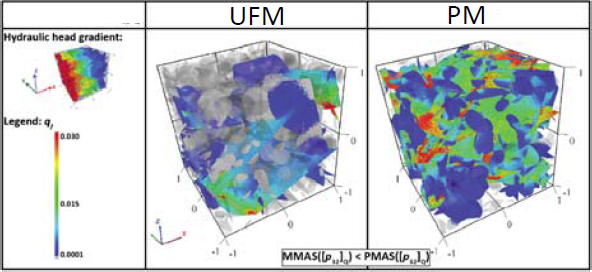Definition and flow analysis of UFM model for the Forsmark site
Project Description
The Forsmark site is studied in the context of the Swedish nuclear disposal project. One key step is defining, at the relevant depths ‐ from 200 to 400m ‐ a Discrete Fracture Network (DFN) model. The DFN modeling framework is based on simplified rules that mimic the kinematic processes governing fracture nucleation, growth and arrest (models are named UFM for likely Universal Fracture Model). Within this framework, beyond a certain density and fracture size scale lc, an invariant regime arises: this “arrest regime” is dominated by the arrest rule and displays an invariant scaling exponent (au= 4). Below lc, in the “growth regime”, the dominating process is the growth process. The data available at the area of interest are consistent with the UFM framework for a transition scale lc equal to 5 m. Flow properties of the UFM model are next analyzed.
Itasca's Role
The project is a collaboration with the University of Rennes. Numerical simulations explore the relation between DFN equivalent permeability (using simple permeameter boundary conditions) and the UFM properties, such as fracture size distribution, spatial organization and transmissivity distribution. This includes comparisons between classical Poisson DFN Models (PM) and UFM models in both the arrest and the growth regimes.
Project Results
In both PM and UFN models, beyond a certain range of fracture sizes and connectivity level, the equivalent permeability is controlled by fracture density P32. However, for the UFM DFN model, the equivalent permeability is lower and flow channeling is higher than for the PM model (see figures 1 and 2). Higher flow channeling is more consistent with in‐situ hydraulic data. Hence the UFM advanced modelling framework potentially reflects better natural fracture properties than Poisson models. The contribution to the overall flow of a distribution of transmissivities, correlated or not to the fracture sizes, is also assessed.
In both PM and UFN models, beyond a certain range of fracture sizes and connectivity level, the equivalent permeability is controlled by fracture density P32. However, for the UFM DFN model, the equivalent
permeability is lower and flow channeling is higher than for the PM model (see figures 1 and 2). Higher flow channeling is more consistent with in‐situ hydraulic data. Hence the UFM advanced modelling framework
potentially reflects better natural fracture properties than Poisson models. The contribution to the overall flow of a distribution of transmissivities, correlated or not to the fracture sizes, is also assessed.
Project Image(s)


References
Davy, P., R. Le Goc, and C. Darcel (2013), A model of fracture nucleation, growth and arrest, and consequences for fracture density and scaling, Journal of Geophysical Research: Solid Earth, 118(4), 1393‐1407.
Maillot, J., P. Davy, R. Le Goc, C. Darcel, and J. R. de Dreuzy (2016), Connectivity, permeability, and channeling in randomly distributed and kinematically defined discrete fracture network models, Water Resources Research, 52(11), 8526‐8545.

